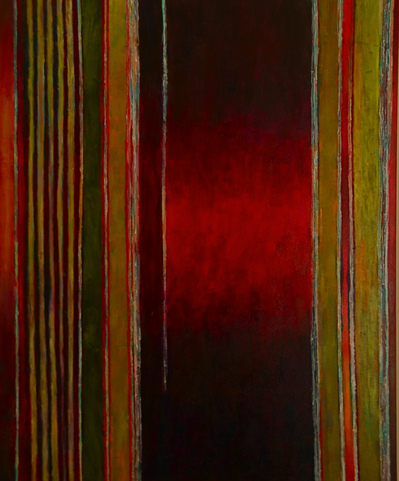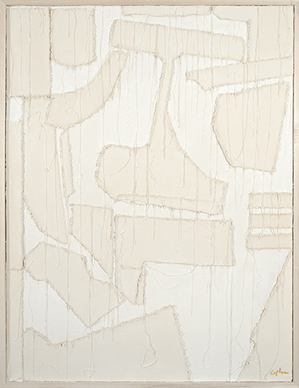Kerrytown Concert House showcases latest explorations of painter Nathan Caplan

"Stripes No. 7" by Nathan Caplan
As this University of Michigan emeritus professor of psychology (and lifelong painter) says in his gallery statement, “What keeps me going is the discovery that when you love a thing long enough it will tell you its secrets—and I continue to uncover new secrets, even at 80.”
For Caplan, each canvas is a point of departure to discover new breakthroughs in the work he’s produced.
There are few eras that result in the opportunity to reinvent the concept of art. But mid-20th century New York City (like Florence in the 16th century or Paris in the 19th century) was one such period.
Caplan was in the thick of this environment. And his interest in the lessons of the New York School’s post-painterly color field abstraction remains vivid to this day. But rather than remain hostage to the past, he extends this formidable heritage with his multifaceted aesthetic.
He exploits the gestural qualities of the first generation of American abstractionists with the penchant for color field studies of the second generation.
Color field abstraction is typified by large surfaces of flat color applied across (or stained in) the working canvas to create unbroken expanses that absorb the viewer when seen from the proper perspective.
Meanwhile, mastering the flow of gesture is a highly controlled aesthetic that only looks unruly. It requires self-control so precise it evades the ordinary artist.
And it’s in these seeming contradictory areas that Caplan most fruitfully continues his “explorations and experiments.”
These latest explorations have taken him to a ground that consolidates the strengths of color field and gestural abstraction through a subtle assessment of three-dimensional space on the surface of his canvas.
The result is often stunning as Caplan’s secondary application of jagged canvas—or the thickened application of his pigments—can thrust forward as distinct spatial eruptions, or subtly manifest themselves through irregular surface protrusions that rise and fall.
Of the 16 Caplan paintings on display, “Stripes No. 7” is a particularly stalwart 4-by-5-foot oil over canvas painting that bears the closest proximity to old-school abstraction. A rich red ground anchors the painting’s base and an alternating series of mottled red and brown vertical stripes fan out from the work’s center. The demarcation of these stripes’ roughened borders gives the work a rough-hewn energy.
Caplan’s5-by-3-foot “Homage to Caravaggio No. 2,” a 2010 Artists Magazine All-Media Competition Finalist painting, finds him working out the implication of his application while also working strips of heavy canvas into the final arrangement. These strips give the work a sense of forceful relief, with their edges giving the painting a three-dimensional dynamic to which the eye reacts.

"No. 4" by Nathan Caplan
A work that explores the least of compositional elements, the painting consists of essentially two grounds of canvas: a bracing primed background upon which Caplan’s signature overlaid canvas has been set in irregular patterns. “No. 4” is a stunning study in minimal chromaticity and maximal geometric integrity.
Caplan throws himself—and all the lessons he’s absorbed through the course of his lengthy career—into this handsome painting’s jagged patterns whose faint interaction of color, relief, and design mesh effortlessly into a spirited whole.
“Caplan at 80: Explorations, Experiments and Prospects” will continue through June 29 at the Kerrytown Concert House, 415 N. Fourth St. Exhibit hours are 11 a.m.-5 p.m. Monday-Friday. For information, call 734-769-2999.

